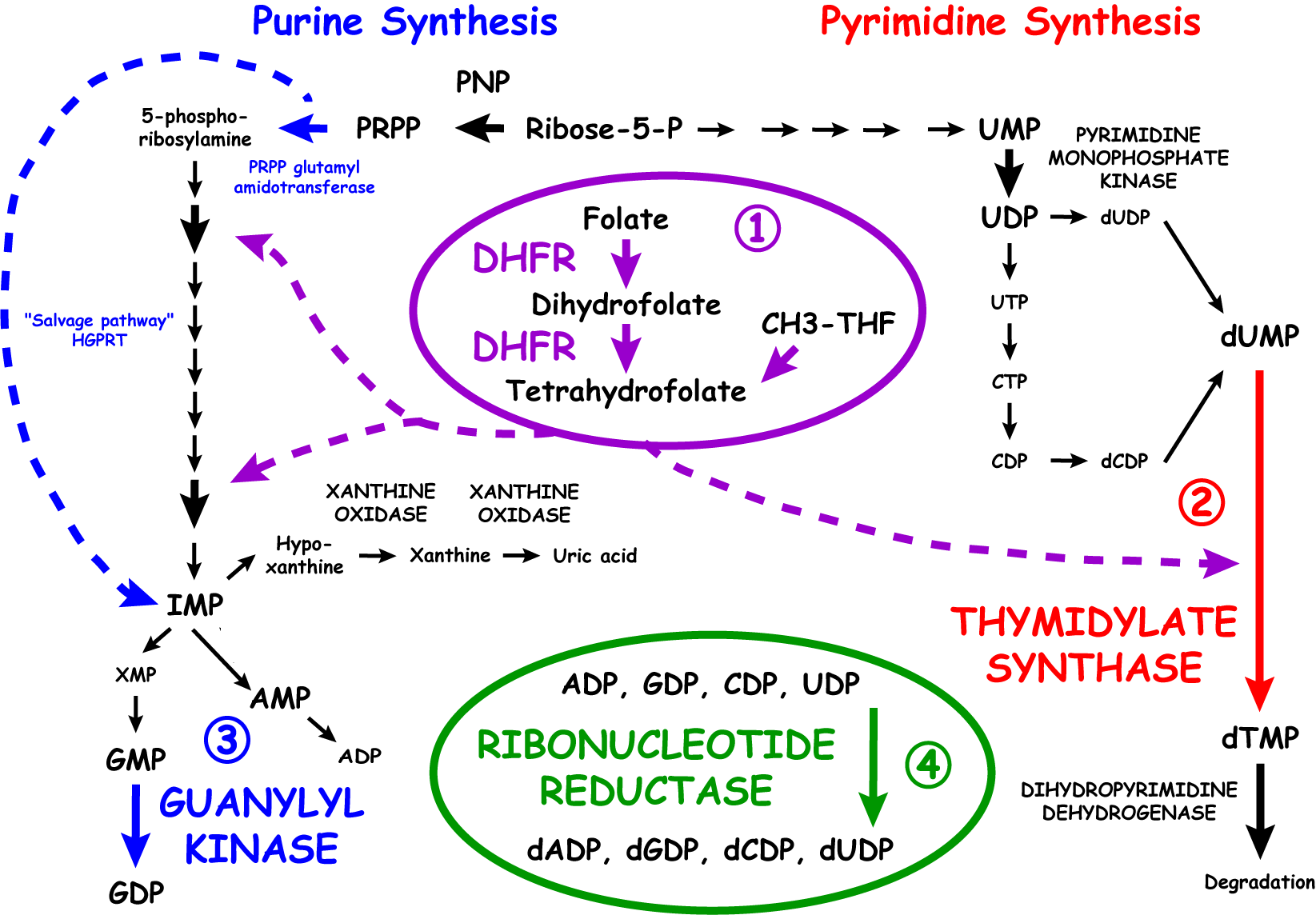 |
| Previous Image | Next Image |
| Description: 1. FOLATE BIOCHEMISTRY (METHOTREXATE, PEMETREXED) Tetrahydrofolate is synthesized by two mechanisms: Conversion of folate to dihydrofolate and dihydrofolate to tetrahydrofolate is catalyzed by dihydrofolate reductase (DHFR). Methyltetrahydrofol ate from liver stores is converted to tetrahydrofolate, a reaction that requires VITAMIN B12. Two steps in the conversion of 5-phosphoribosylamine to IMP (purine synthesis) use tetrahydrofolate as a carbon donor. Tetrahydrofolate is also involved in the generation of dTMP from dUMP (pyrimidine synthesis) – this reaction is catalyzed by thymidylate synthase (see 2A below). 2. PYRIMIDINE SYNTHESIS (5-FLUOROURACIL, CAPECITABINE) The rate limiting step in DNA synthesis is the conversion of UMP to TMP, which is catalyzed by thymidylate synthase. Conversion of UMP to UDP is catalyzed by pyrimidine monophosphate kinase; this reaction is important in the development of resistance to 5-FU. One step in the degradation of thymidine nucleotides is catalyzed by dihydropyrimidine dehydrogenase; an inherited deficiency of this enzyme leads to greatly increased sensitivity to 5-FU. 3. PURINE SYNTHESIS (6-MP, 6-TG) De novo purine synthesis begins with the conversion of ribose-5-phosphate to 5‑phosphoribosyl-1‑pyrophosphate (PRPP), a reaction catalyzed by purine nucleoside phosphorylase (PNP). The first committed step in purine synthesis is the formation of 5‑phosphoribosylamine via the enzyme PRPP glutamyl amidotransferase. IMP and GMP can also be created by via the “salvage pathway” whereby PRPP is combined with hypoxanthine or guanine bases (including 6-MP and 6-TG) by the actions of hypoxanthine-guanine phosphoribosyl transferase (HGPRT). 6-MP and 6-TG (and their naturally occurring analogues) inhibit guanylyl kinase, preventing the conversion of GMP to GDP and causing "pseudofeedback inhibition" of PNP, PRPP and HGPRT. One route for the degradation of purine nucleotides (and 6-MP and 6-TG) occurs via conversion of IMP to uric acid. Two steps in that process, conversion of hypoxanthine to xanthine and xanthine to uric acid, are catalyzed by the enzyme xanthine oxidase. This enzyme is inhibited by ALLOPURINOL. 4. CONVERSION OF RIBONUCLEOTIDES TO DEOXYRIBONUCLEOTIDE S (HYDROXYUREA) This reaction is catalyzed by ribonucleotide reductase. Picture Stats: Views: 1946 Filesize: 94.44kB Height: 1144 Width: 1645 Source: https://biology-forums.com/index.php?action=gallery;sa=view;id=12245 Keywords: Review of nucleotide biochemistry |
